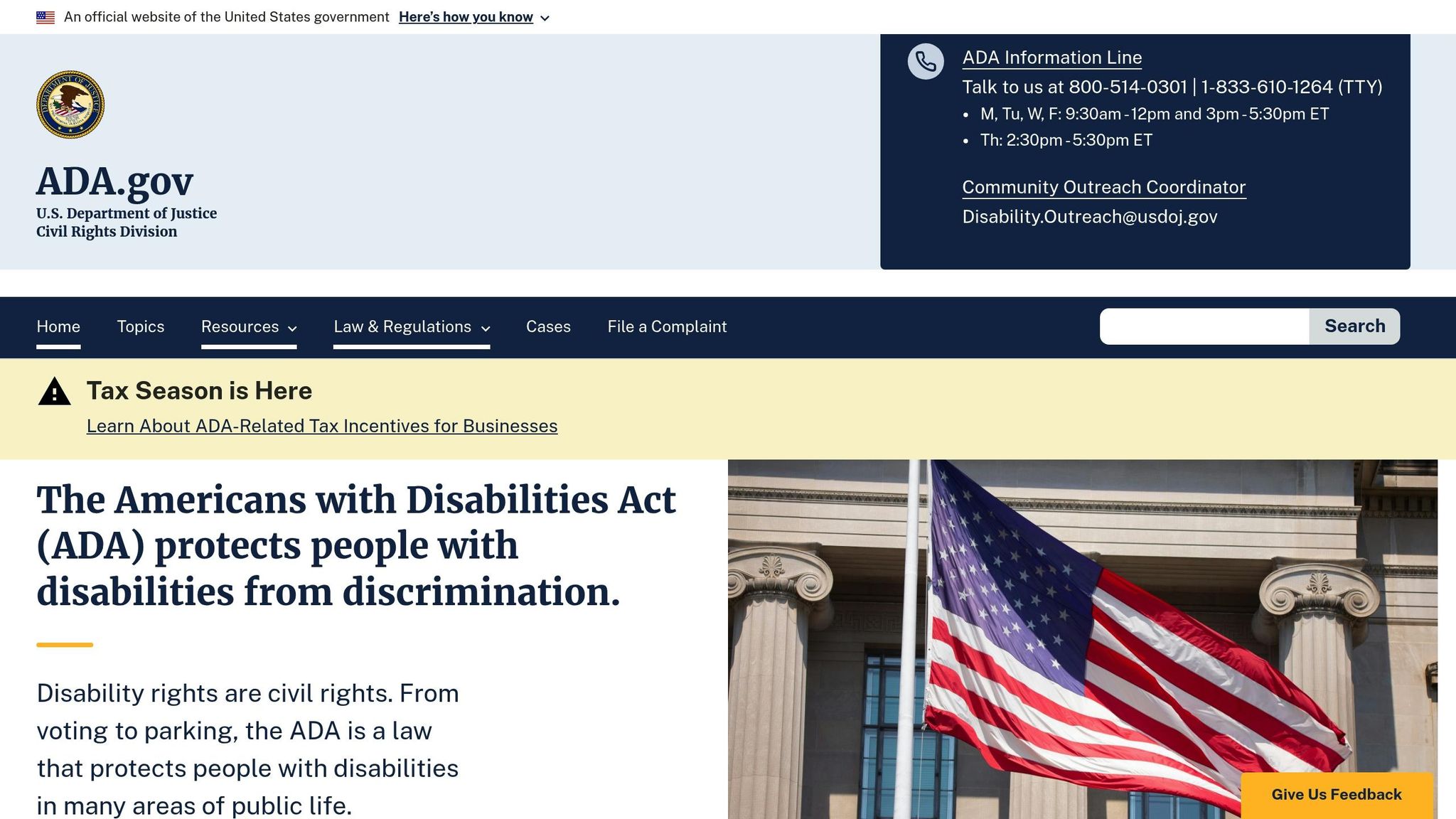Accessibility isn’t just ethical - it’s a smart business move. Companies that prioritize accessibility see higher revenue (28%), profit margins (30%), and customer loyalty (60%). With a global disability market valued at $18 trillion by 2025, ignoring accessibility means missing out on a massive audience.
Here’s why it matters:
- Market Reach: 27% of U.S. adults have disabilities, and 71% leave inaccessible websites immediately.
- Economic Impact: Accessibility boosts conversions by 37% and reduces support costs by up to 68%.
- Legal Risks: ADA lawsuits cost up to $350,000, making compliance crucial.
- Proven ROI: Every $1 invested in accessibility yields $100 in returns.
Accessibility isn’t just compliance - it’s about creating inclusive experiences that drive loyalty and growth.
From Compliance to Advantage: The Hidden ROI of Accessibility
Why Accessibility Matters for Business Success
Accessibility isn't just about doing the right thing - it's a key driver of customer loyalty and market success. Research consistently shows that businesses prioritizing accessibility see tangible benefits, from increased customer retention to noticeable revenue growth. Let’s break down why accessibility is such a powerful tool for business.
Market Reach and Customer Base Growth
Making your platforms accessible means opening your business to a massive, often overlooked audience. In the U.S., 27% of adults live with some form of disability. If your website or platform isn’t accessible, you’re potentially excluding more than a quarter of your potential customers.
The numbers don’t lie: 71% of users with disabilities leave inaccessible websites immediately. And as the global population ages - 17% of people worldwide are projected to be over 65 by 2050 - the demand for accessible design will only grow. Accessibility ensures you’re not leaving money on the table.
Economic Impact of Disability Markets
The financial case for accessibility is equally compelling. Here’s what the numbers show:
| Market Segment | Economic Impact |
|---|---|
| Global Disability Market | $2 trillion in annual disposable income |
| E-commerce Revenue Loss Due to Non-compliance | $6.9 billion annually |
| Revenue Boost from Accessible Sites | 37% increase in conversions |
| Customer Loyalty Impact | 60% rise in repeat customers |
These figures make one thing clear: investing in accessibility isn’t just ethical - it’s smart business. Meeting accessibility standards like ADA and WCAG doesn’t just expand your audience; it also strengthens your bottom line.
ADA and WCAG Compliance Benefits

Beyond market growth, accessibility compliance helps businesses avoid costly legal pitfalls while building trust with their audience:
- The cost of a single accessibility lawsuit can reach approximately $350,000.
- Settlements typically range from $5,000 to $20,000.
- In 2023, federal ADA lawsuits exceeded 8,200.
"When you commit to building an accessible website, you send a message to the entire community about your support of the cause. This positions your organization as a brand that cares for the disabled. As a result, your business will get favorable reviews and recommendations from people that matter."
– Roland Neal So, Credera
"A person with a disability has to be innovative just to get through the day, imagine how that mindset helps a team at a workplace."
– Mark Wafer, Ontario Disability Employment Network
Steps to Build Accessible Customer Experiences
Creating accessible customer experiences involves a thoughtful approach that blends technical know-how with a focus on user needs.
How to Run Accessibility Tests
Automated tools alone can only identify 30–40% of accessibility issues. To ensure thorough coverage, a combination of testing methods is essential.
-
Automated Testing
Use automated tools to scan high-traffic pages and set up regular checks. These tools can help pinpoint issues such as:- Missing alt text
- Poor color contrast
- Problems with keyboard navigation
- Insufficient form field labels
- Incorrect semantic HTML structure
-
Manual Testing
Go beyond automated scans by conducting manual reviews. This helps evaluate:- Compatibility with screen readers
- Keyboard navigation functionality
- Form submission processes
- Clear error messaging
- Consistent behavior for interactive elements
-
User Testing
Partner with individuals who have disabilities to uncover overlooked challenges and gain a deeper understanding of real-world user experiences.
"Testing is so inextricably linked with an accessible end product, that it is almost impossible to achieve accessibility without it." - Recite Me
Incorporating these methods into your accessibility strategy ensures a more inclusive and seamless digital experience for all users.
Digital Design Best Practices
After rigorous testing, apply design principles that cater to everyone. With much of the internet still inaccessible to people with disabilities, following these guidelines can make a big difference:
| Design Element | Requirement | Impact |
|---|---|---|
| Color Contrast | Minimum 4.5:1 ratio for normal text | Improves readability for users with low vision |
| Touch Targets | At least 44x44 pixels | Enhances usability for individuals with motor impairments |
| Form Fields | Clear labels and error messages | Reduces confusion during interactions |
| Images | Descriptive alt text | Aids screen reader users in understanding visual content |
"My new rubric for a design requires me to not only make something that looks beautiful and suits the intended purpose, but is as accessible as possible. If it isn't accessible, I haven't done my job." - Sarah Ippen, Senior UI/UX Designer, AudioEye
Making Payments More Accessible
Accessibility shouldn’t stop at design and navigation - it’s equally important for transactions. A study found that 84% of blind and low-vision users consider accessibility a deciding factor in whether they return to a service. To improve payment accessibility, consider these features:
-
Multiple Interface Options
- Voice-enabled payment systems
- High-contrast visual displays
- Tactile keypads with Braille
- NFC payment options for contactless transactions
-
Clear Communication
- Step-by-step instructions for processes
- Error messages that explain solutions
- Receipts available in various formats
- Audio confirmation for transactions
"Accessibility in payments means ensuring that everyone, regardless of physical or cognitive abilities, socioeconomic background, or geographic location, can use financial services with ease and confidence." - Kurt Schmid, Managing Director Digital Banking, Netcetera
It’s worth noting that accessibility improvements often benefit all users. For instance, in 2022, Google launched its Accessibility Discovery Centre (ADC) in London. This facility brings together engineers and members of the disability community to co-create products that eliminate barriers.
sbb-itb-97f6a47
Tracking Accessibility ROI
Quantifying the value of accessibility improvements can reveal their direct impact on business performance. For instance, accessible e-commerce platforms often see 50% higher conversion rates and 40% lower cart abandonment rates, demonstrating the financial benefits of accessibility investments.
Customer Retention Metrics
Tracking customer retention after implementing accessibility features involves evaluating key performance indicators, such as:
| Metric | Average Increase | Business Impact |
|---|---|---|
| Customer Retention Rate | 22% increase | Boosts customer lifetime value |
| Support Ticket Volume | 68% reduction | Cuts operational costs |
| Repeat Purchase Rate | 45% increase | Drives consistent revenue growth |
A standout example is Tesco's partnership with RNIB in 2024. By improving screen reader compatibility, Tesco not only achieved a 350% increase in sales but also significantly reduced support costs. While these retention gains are measurable, addressing customer loss is equally critical.
Customer Loss Prevention
Accessibility plays a key role in preventing customer loss. Research highlights that 71% of users will leave a site within 10 seconds if it’s not accessible. Furthermore, improving retention by just 5% can boost profits by 25% to 95%. Companies prioritizing accessibility report 28% higher revenue and 30% higher profit margins, with Forrester's 2022 study showing a 99% ROI - every dollar invested yields $100 in return.
"Digital accessibility is not just about compliance but about tapping into a huge, loyal audience. There are over a billion people with disabilities worldwide, many of whom rely heavily on online shopping."
– Molly Burke, Senior Retail Analyst at Software Advice
These metrics not only reduce customer loss but also improve satisfaction, as reflected in Net Promoter Scores (NPS).
NPS and Accessibility Links
Net Promoter Score (NPS) offers another lens to evaluate accessibility’s business impact. Companies with strong accessibility practices experience 30% higher NPS and 2.5 times more referrals. Accessibility also attracts 71% of customers and convinces 67% to pay a premium for accessible services. Moreover, accessible service desks report 20–40% higher satisfaction rates.
Microsoft's Xbox Adaptive Controller initiative is a prime example. This project achieved 91% satisfaction among disabled gamers, increased console loyalty by 28%, and unlocked a $1 billion market segment.
"Metrics allow us to track the performance and value of our programs. And when you can show value, you can drive change."
– Jaunita Flessas, Senior Digital Accessibility Leader, Navy Federal Credit Union
Working with Accessibility Consultants
Choosing the right accessibility consultant can strengthen customer loyalty while ensuring compliance. To find the best fit, consider using the Top Consulting Firms Directory and evaluate potential consultants based on these key factors:
| Qualification Area | Essential Criteria | Impact on Customer Loyalty |
|---|---|---|
| Technical Expertise | Deep understanding of WCAG, ADA, and Section 508 | Ensures compliance and minimizes legal risks |
| Certifications | Credentials like CPACC, WAS, and CPWA from IAAP | Confirms expertise and reliable methodologies |
| Testing Approach | Combination of automated and manual testing | Improves issue detection compared to automated-only methods |
| Project Experience | Proven success in similar industries | Offers tailored insights and efficient execution |
Expert accessibility consultants typically charge between $50 and $200 per hour, with project-based fees ranging from $1,000 to $10,000, depending on the scope of work. These qualifications ensure your consultant not only meets compliance standards but also enhances customer trust and engagement.
Real Business Success Stories
Partnering with an accessibility expert can deliver measurable results. Take the collaboration between UW-IT and Trumba, which improved the accessibility of Trumba’s event calendar service and boosted user engagement.
"We really appreciated the help and the extensive evaluation that the UW-IT team did before involving Trumba. It can be difficult to put yourself in the shoes of people with accessibility issues; Hadi's perspective was so useful. In addition to his experience as a person who relies on assistive technologies, he has a background in computer science and development. That combination of attributes means that Hadi understands the challenges of making software more accessible. He doesn't just point out the issues that need fixing. He has great ideas and is current on the latest options for solving a problem."
- Dan Hickman, Trumba CEO
To maximize the value of your consultant partnership, schedule regular consultations - biweekly or monthly. Service managers should also conduct hands-on tests, like navigating interfaces with a keyboard only, to uncover user challenges.
A strong relationship with your consultant can amplify your accessibility efforts while deepening customer engagement. Successful partnerships often include:
- Initial Assessment and Implementation: Consultants perform audits and help resolve accessibility barriers.
- Ongoing Monitoring: Monthly retainer services, typically costing $500 to $2,000, provide continuous support and ensure compliance with evolving standards.
Conclusion
Making accessibility a priority isn't just the right thing to do - it’s a smart business move. Retailers who integrate digital accessibility features have reported a 60% boost in customer loyalty. That kind of loyalty can transform casual shoppers into lifelong customers.
The numbers tell an even bigger story. The global disabled community holds $13 trillion in annual disposable income. Yet, as of 2022, only 3% of the internet is accessible to people with disabilities. This gap presents a massive opportunity for businesses to stand out and capture untapped market share.
"As a person with a disability myself, I can tell you that when people with disabilities find a business that meets their needs, they're more likely to come back. Accessibility fosters loyalty." - Matt Ater, Senior Vice President, TPGi
The impact of accessibility improvements can be staggering. For instance, when a major ecommerce platform improved the accessibility of a single form button, it led to a 45% increase in completed purchases, generating an additional $300 million in revenue. These outcomes make it clear: accessibility isn’t just about compliance - it’s about driving results.
Investing in accessibility enhances the customer experience, builds trust, and cultivates loyalty. In a competitive marketplace, businesses that prioritize accessibility are positioning themselves for long-term success.
"Solve for one, extend to many. Everyone has abilities, and limits to those abilities. Designing for people with permanent disabilities actually results in designs that benefit people universally. Constraints are a beautiful thing." - Microsoft
FAQs
How does focusing on accessibility help build stronger customer loyalty and retention?
Making your products and services accessible isn’t just the right thing to do - it’s smart business. When you ensure that everyone, including people with disabilities, can easily use what you offer, you create a smoother, more inclusive experience. This makes customers feel appreciated and increases the chances they’ll keep coming back.
Accessibility also plays a big role in reducing frustration and boosting satisfaction. When users can interact with your business effortlessly, it builds trust - an essential ingredient for customer retention. Plus, showing that you care about meeting the needs of all your customers enhances your brand’s reputation, making it more likely to inspire long-term loyalty. It’s a win-win for everyone.
How can businesses make their websites more accessible to users with disabilities?
To make websites easier for everyone to use, businesses can take a few important steps. First, ensure compatibility with screen readers by using proper HTML tags, such as headings and lists. These tags help assistive technologies interpret the content accurately. Adding descriptive alt text for images is another critical step, as it allows users who can't see the visuals to understand their purpose.
Other key practices include using high-contrast color schemes for text and backgrounds, enabling users to resize text up to 200% without losing functionality, and providing captions or transcripts for all audio and video content. Additionally, websites should be fully keyboard-navigable, which is essential for users with motor impairments. These measures not only improve accessibility but also enhance the overall user experience, fostering stronger customer connections.
What legal and financial risks do businesses face if they ignore accessibility standards like ADA and WCAG?
Businesses that don't comply with accessibility standards like the Americans with Disabilities Act (ADA) or the Web Content Accessibility Guidelines (WCAG) open themselves up to serious legal and financial risks. Non-compliance can trigger lawsuits, including class actions, with initial fines often surpassing $75,000. Repeat violations? Those can climb to over $150,000. And that's just the start - there are also legal fees, settlements, and penalties from both state and federal agencies to worry about.
From a financial perspective, fixing accessibility issues after the fact is usually far more expensive than addressing them upfront. But the costs aren't just monetary. Companies that ignore accessibility risk damaging their reputation, which can erode customer trust and loyalty. In a market where consumers increasingly value inclusivity, making accessibility a priority isn't just about following the law - it's a smart move for any business.


